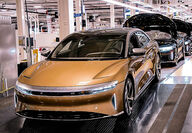Sorted by date Results 1 - 13 of 13

Rising demand, lack of domestic supply, and China's dominance. While graphite has not captured the same level of media attention as some of the other mined materials critical to the clean energy transition, the strategic nature of this largest ingredient in lithium-ion batteries powering electric vehicles is high on the list of concerns for American automakers, Washington policymakers, and the Pentagon's top brass. These worries are based on a trifecta of graphite...

An all-of-government strategy is beginning to unfold in the US. Over the first two years following the passage of the Bipartisan Infrastructure Law and Inflation Reduction Act, the U.S. Department of Energy has invested billions of dollars into establishing a clean energy supply chain in the United States. These heavy investments, however, have neglected one vital link – the domestic mines needed to supply the processing facilities, battery plants, and other energy t...

Import-reliance a top concern for national security officials. America's heavy reliance on China and others for the minerals and metals critical to the nation's economic competitiveness, military strength, and clean energy future is high on the list of strategic concerns for top brass at the U.S. departments of Defense and Homeland Security. While much of this concern is rooted in the fact that the United States' ability to defend its strategic interests at home and abroad...

Lynas to apply the Pentagon funds to develop the first heavy rare earths separation facility outside of China. Continuing its heavy investments into America's critical mineral supply chain, the U.S. Department of Defense has allocated roughly $258 million to support development of the Lynas U.S. Rare Earths processing facility in Texas, which is more than double the original $120 million price tag for establishing the first large-scale heavy rare earth elements separation plan...

With the world-class deposits already found within its borders, the United States has the potential to be a major global producer of copper, lithium, and the other minerals and metals critical to the clean energy transition. Realizing this potential, however, will require reserves of political will in Washington, DC, that match the nation's domestic energy metals endowment, according to R Street Institute. "Despite political rhetoric and policies promoting the use of domestic...

To help shore up domestic supplies of the cobalt, graphite, lithium, nickel, and other materials that go into lithium-ion batteries, the U.S. Department of Energy has directed $3.16 billion from the $1 trillion Infrastructure Investment and Jobs Act to bolster supply chains. This multi-billion-dollar funding comes a month after President Biden authorized the Pentagon to utilize the estimated $750 million of available Defense Production Act Title III funding to establish and...

With a "substantially complete" application for a loan to fund the development of its Rhyolite lithium-boron project in Nevada already being processed by the U.S. Department of Energy Loan Programs Office, ioneer Ltd. is positioned to be one of the early beneficiaries of the more than $20 billion in federal loans and loan guarantees available to mining and manufacturing companies along the electric vehicle battery materials supply chain. Early in 2021, ioneer entered into...

US invests heavily into developing domestic rare earth element processing plants Despite what their name suggests, rare earths are not all that scarce. An efficient and environmentally sound technology capable of separating this tightly bonded group into the 15 individual elements of innovation, however, is truly unique and the key to establishing a rare earths supply chain in North America. There are currently no commercial-scale rare earths separation facilities in North...

The United States' withdrawal of troops from Afghanistan opened the door for China to swoop in and lay claim to the more than $1 trillion worth of lithium, rare earths, and other metals and gems estimated to lie below a landscape marked by more than 40 years of continuous war. Digging up the rich natural resources in Afghanistan will not be easy and it is not likely that China will consider the now Taliban-run country as a dependable source of critical minerals and metals in t...

From $15 billion to bolster clean energy research to incentives aimed at encouraging Americans to buy electric vehicles, the Biden administration's proposed $174 billion investment in the United States EV industry is a once-in-a-generation strategy that is missing a key piece – a plan to secure the minerals needed to manufacture these vehicles and the batteries that go in them. In a new fact sheet that outlines its plan to supercharge U.S. transportation and manufacturing, t...

The American clean energy revolution envisioned by the Biden administration is going to require a massive supply chain upgrade – from the mines feeding rare earths, battery metals and other materials into the front end, to the manufacturers that will utilize these mined materials to build the electric vehicles and renewable energy infrastructure needed for a low-carbon future. In a move that demonstrates the newly elected administration's hopes that a transition to l...

While laying out an action plan to establish the national network of electric vehicle charging stations needed to keep pace with its ambitious goal of 50% of all vehicles sold in the United States being electric by 2030, the Biden administration reiterated that domestic battery manufacturing and critical minerals supplies are key aspects of the overall EV strategy. The White House is backing up this commitment to domestic battery supply chains with roughly $20 billion in loan...

The global transition to electric vehicles plugged into renewable energy sources is powering enormous demand for graphite, the single largest ingredient in lithium-ion batteries. "Graphite demand increases in both absolute and percentage terms since graphite is needed to build the anodes found in the most commonly deployed automotive, grid, and decentralized batteries," the World Bank penned in a 2020 report, "The Mineral Intensity of the Clean Energy Transition." According...